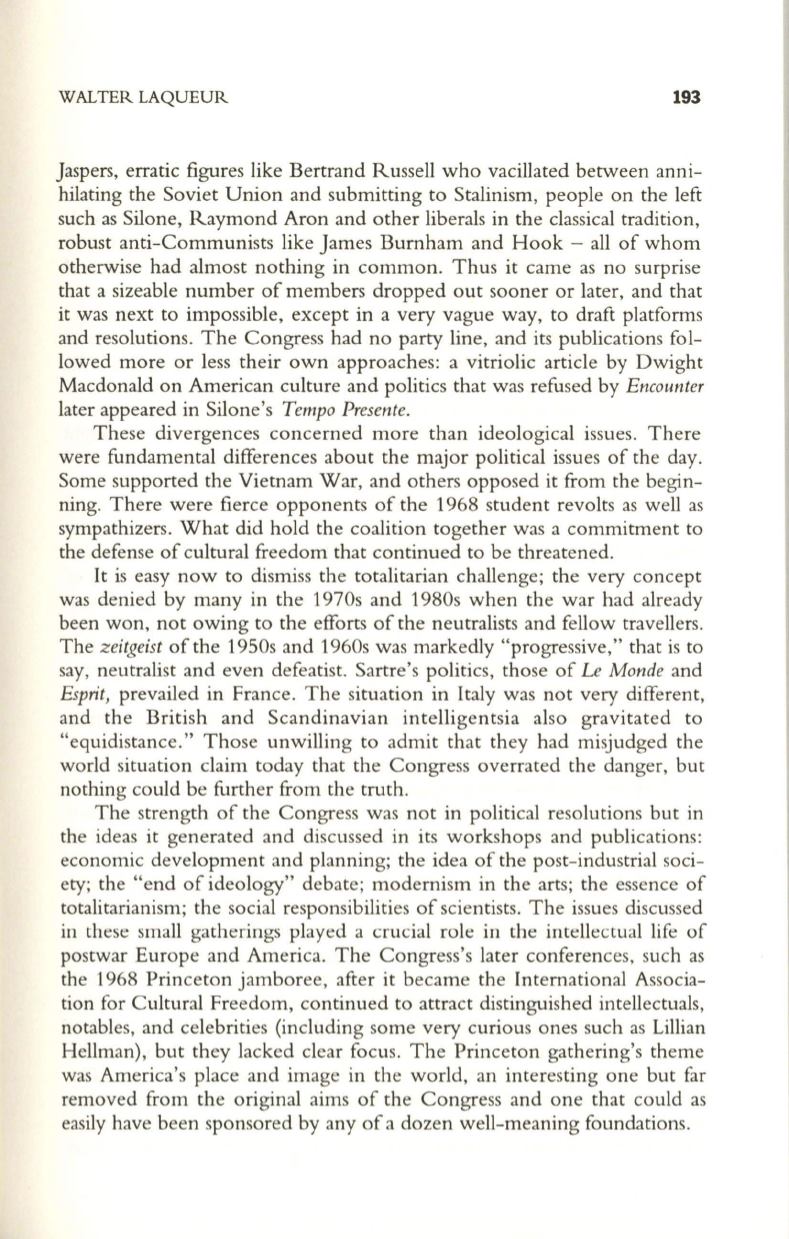
WALTER LAQUEUR
193
Jaspers, erratic figures like Bertrand Russell who vacillated between anni–
hilating the Soviet Union and submitting to Stalinism, people on the left
such as Silone, Raymond Aron and other liberals in the classical tradition,
robust anti-Communists like James Burnham and Hook - all of whom
otherwise had almost nothing in common. Thus it came as no surprise
that a sizeable number of members dropped out sooner or later, and that
it was next to impossible, except in a very vague way, to draft platforms
and resolutions. The Congress had no party line, and its publications fol–
lowed more or less their own approaches: a vitriolic article by Dwight
Macdonald on American culture and politics that was refused by
Encounter
later appeared in Silone's
Tempo Presente.
These divergences concerned more than ideological issues. There
were fundamental differences about the major political issues of the day.
Some supported the Vietnam War, and others opposed it from the begin–
ning. There were fierce opponents of the 1968 student revolts as well as
sympathizers. What did hold the coalition together was a commitment to
the defense of cultural freedom that continued to be threatened.
It is easy now to dismiss the totalitarian challenge; the very concept
was denied by many in the 1970s and 1980s when the war had already
been won, not owing to the efforts of the neutralists and fellow travellers.
The
zeitgeist
of the 1950s and 1960s was markedly "progressive," that is to
say, neutralist and even defeatist. Sartre's politics, those of
Le
Monde
and
Esprit,
prevailed in France. The situation in Italy was not very different,
and the British and Scandinavian intelligentsia also gravitated to
"equidistance." Those unwilling to admit that they had misjudged the
world situation claim today that the Congress overrated the danger, but
nothing could be further from the truth.
The strength of the Congress was not in political resolutions but in
the ideas it generated and discussed in its workshops and publications:
economic development and planning; the idea of the post-industrial soci–
ety; the "end of ideology" debate; modernism in the arts; the essence of
totalitarianism; the social responsibilities of scientists. The issues discussed
in these small gatherings played a crucial role in the intellectual life of
postwar Europe and America. The Congress's later conferences, such as
the 1968 Princeton jamboree, after it became the International Associa–
tion for Cultural Freedom, continued to attract distinguished intellectuals,
notables, and celebrities (including some very curious ones such as Lillian
Hellman), but they lacked clear focus. The Princeton gathering's theme
was America's place and image in the world, an interesting one but far
removed from the original aims of the Congress and one that could as
easily have been sponsored by any of a dozen well-meaning foundations .


